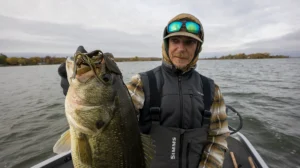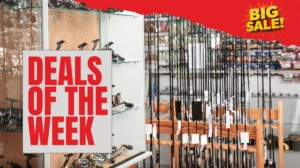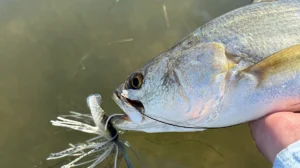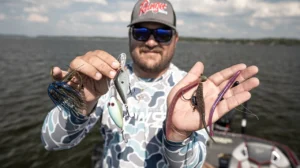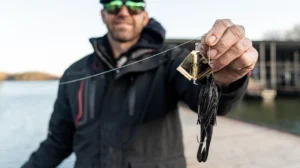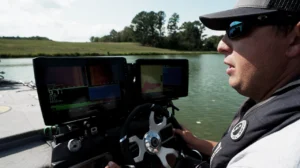Bass fishing spinnerbaits have been around for a very long time. There are hundreds of companies, big and small, that make spinnerbaits for local stores as well as national retailers. With such a saturated market, little tweaks to this age-old lure have been made to help newcomers to the market take a foothold, as well as ensure old staples stay out front.
The evolution of the spinnerbait has refined this lure to the point of near perfection and the leaders in this demographic all have a few things in common. This means there are a handful of things to look for when shopping for a high-quality spinnerbait. Today, we’re going to lay a few of those out.

Quality swivel
A quality swivel is perhaps the most distinguishing component in the composition of a quality spinnerbait. Companies can skimp here and there on some of these other traits we’ll list as we move forward. But if a subpar swivel is used, the blades won’t spin smoothly or for long and the spinnerbait is as good as garbage after a few trips.
The image here shows what to look for, as this is a great swivel. These swivels are so important and of such high quality, that they’ll often be the only component I salvage from an old spinnerbait to use to build a new one. When the rest of the lure is useless, these swivels still have a lot of life left in them.

Trailer keeper
Soft-plastic trailers aren’t always a necessity when fishing a spinnerbait. But in many situations, a soft-plastic trailer really sets off and completes a spinnerbait’s profile or action.
Take a double Colorado spinnerbait in muddy water or night blade, for instance. Adding a twin tail grub to the back of both of these gives each of them a bigger profile and makes them easier for the bass to find. If your spinnerbait doesn’t have a quality bait keeper to keep these trailers locked in place, you’ll spend a lot time reeling in a goofy-looking bait and sliding your soft plastic back up the hook after each cast.

Strong hook
It’s hard to rank the importance of these different characteristics, as a spinnerbait blade won’t spin with a junky swivel, but getting a bite is useless if the hook’s not strong enough to get the fish to the boat. So I stress that these aren’t really in order of importance, but instead should all be things you look for when selecting a spinnerbait.
The hook should be fairly stout, not super thin; thinner hooks have a tendency to bend. It’s hard to tell sometimes by just looking at the hook in the packaging if it’s strong enough, but it is typically pretty easy to tell if a hook looks too thin on the other hand. As long as the hook isn’t alarmingly skinny, you should be good. And the stock bend in the hook will also help you pick out a stronger hook, as a circular bend is strong as well as an O’Shaughnessy bend, where the hook point turns slightly in like you see here.

Appropriate tensile strength wire
Light-wire spinnerbaits give off a lot of vibration, as the thinner wire oscillates more than a thicker wire would. However, this quick and repeated bending of the wire can actually weaken it over time and cause it to break. You can see this same thing occur anytime you want to cut a small wire but don’t have any pliers. If you bend it back and forth really quickly, it will break.
Though the tensile strength of a spinnerbait arm is much stronger than most of the little wires you’d be bending to break by hand, you can still overpower a thin wire with a big blade and the arm can break from this small but repetitive bending. Unfortunately, the break often occurs when you get a bite and there’s the extra force of a bass fighting to free itself.
The main thing to look for: Steer clear of most thin-wire spinnerbaits with double Colorado blades or a big No. 6 willow leaf blade, for instance.

Good finish/paint job
You should do the best you can to ensure the blades and spinnerbait head have high-quality finishes or paint jobs. Duller spinnerbait blades are especially prone to corrosion, which will tarnish the blade and negatively impact its effectiveness at reflecting light in the water. You can typically look at a blade in the pack and if it has a super shiny finish, it’ll hold up pretty good.
Or if the blades are painted, you should look to make sure they still have a little shine to them. This shine is typically a good indicator that the manufacturer used some sort of epoxy or enamel to protect the paint job. Look for this on the painted heads of spinnerbaits as well. If the paint job is flat and not glossy, they’ll usually chip pretty easily.

Well-secured skirt
If you plan to buy a few spinnerbaits and store some of them for an extended period of time, you really want to make sure the skirts are secured to spinnerbait well. Or even if you primarily fish spinnerbaits in the fall and spring, it’s really frustrating when the season rolls around and you go to pull a spinnerbait out only to have the skirt crumble in your hands.
Originally, almost every company used a small, low-quality rubber band to secure a spinnerbait trailer to the bait. But these dry rot quickly and then fall apart, leaving the skirt in a messy pile around the bait. Some companies use high-quality rubber bands now that work well. But some go even a step farther to help reassure customers before they buy the product, using wire or high-strength thread that you can see in the packaging to secure their spinnerbait skirts.

Final thoughts
There are several things you can look at before buying a spinnerbait to ensure that you’re purchasing a quality bait. The trailer keeper, swivel and skirt containment method are good examples. Some things are a little harder to tell with the naked eye though, like the strength of the wire and hook as well as the quality of the finish or paint job of blades and spinnerbait heads.
One thing’s for certain… not all spinnerbaits are created equally. So paying close attention to real deal breakers like the swivel will at least help you keep from making a really bad purchase. Then take your time to flip the bait around in your hands a few minutes and see if you can make assessments on the rest. With a little time and experience, you can develop a pretty good eye and feel for purchasing a quality spinnerbait.




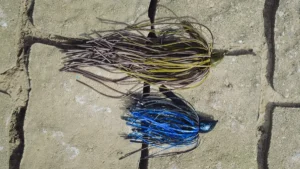
![[VIDEO] Casey Scanlon’s Go-To Trailers for Bladed Jigs](https://www.wired2fish.com/wp-content/uploads/2025/06/scanlon-trailers-300x169.webp)

